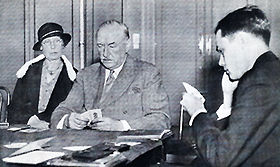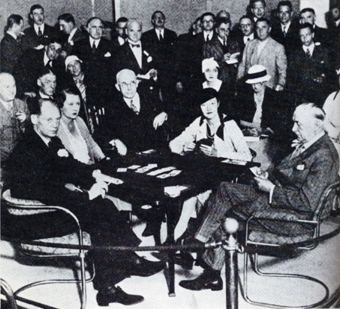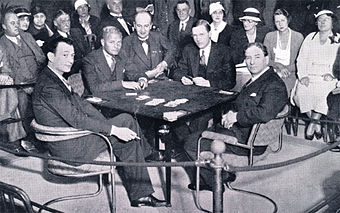
Henry Beasley
Encyclopedia
Lieutenant Colonel
Henry Mountifort Beasley DSO
(1875 – 14 December 1949), known as 'Pops', was a British Army
officer and a leading contract bridge
personality in the early days of the game.
in Uttar Pradesh
, India
, he was educated at Bedford School
, and entered the Royal Military Academy (Woolwich
) on leaving school. Beasley was gazetted to the Royal Artillery
in 1896. He served in India, Burma and China, and took part in the Relief of Peking
after the Boxer Rebellion
. He served in WWI
on the staff of the Anzac Corps
. He was thrice mentioned in despatches and awarded the Distinguished Service Order
(DSO). After the war he served in Germany on the Disarmament Commission. He was an interpreter in French, German and Hindustani
.
 Pops had played all forms of bridge from the days of bridge–whist
Pops had played all forms of bridge from the days of bridge–whist
and auction bridge
. He wrote his first book on this game in 1906, London bridge, which "started the bridge craze in all the fashionable clubs of that day." (Beasley). Like many of the early contract bridge players, he had been an expert auction bridge player in the 1920s. In domestic bridge he was a leading organiser. He had been a member of Almacks club since 1901, and later was a co-founder and Chairman of two leading London card clubs - Crockford's (in St James' Street) and the Hamilton Club (in Hamilton Place). He was also a leading player in the 1930s, winning the Gold Cup
in 1933, and playing in several international events. He was an author and bridge columnist, and the originator of a bidding system named after him.
In bidding, Beasley adopted many of Culbertson's ideas, but was displeased with the strong twos and their negative response of two no trumps. As a result, so he claimed, he was the inventor (in 1936) of the artificial strong two clubs opening bid with its negative response two diamonds. For many years all the British bidding systems used this method of dealing with strong hands: Acol
(both standard and Benjaminised), CAB, Two Clubs and Baron systems all used it. However, it is fair to mention that others have also claimed authorship of this fruitful idea.
team, losing both, but helping to develop the game in Britain.
The first match, Crockford's v. Culbertson, took place in 1930, after the Buller
–Culbertson
match. The Crockford's team was Beasley, Sir Guy Domville (popular society and sporting figure), George Morris and Captain Hogg; the match over 200 boards was won by the Culbertson team by 4,905 points (total points scoring).

 The second match, for the Schwab trophy in 1933, was a more significant event, preceded by the usual brilliant Culbertson publicity. Played at Selfridges
The second match, for the Schwab trophy in 1933, was a more significant event, preceded by the usual brilliant Culbertson publicity. Played at Selfridges
, it was widely reported in the press and on newsreel, and was attended by many spectators. A large periscope was used so that spectators outside the playing-room could glimpse the players. Play could also be followed on a massive electrical scoreboard ("the forerunner to Bridgerama") in the Palm Court area. The teams were: Britain: Beasley & Sir Guy Domville; George Morris & Percy Tabbush; Lady Doris Rhodes
& Graham Mathieson. America: Ely & Josephine Culbertson; Theodore Lightner and Michael Gottlieb. In both teams the pairs sometimes lined up differently.
George Morris and Percy Tabbush were an interesting pair: according to Reese, Morris was "a famous gambler at every card game, and an athlete; he had made a Channel-swimming attempt and played marathon golf for big stakes. His health failed and he was a pitiable sight in later years. Tabbush followed a course that is not common amongst bridge players: he joined a religious sect and turned his back on the 'Devil
's playthings'."
Mathieson's part in the match was curtailed when he fell through a glass roof, to be rescued swinging from a girder above a 40-foot drop! The Culbertson team won by the decisive, but not overwhelming, margin of 10,900 points (total points scoring). Hubert Phillips
, writing in the News Chronicle
, put the reasons as superior teamwork, avoidance of unnecessary risks when vulnerable, and greater precision in slam-bidding. The match was analysed in three books, and had a considerable effect on bidding methods in Britain and elsewhere.
Lieutenant colonel
Lieutenant colonel is a rank of commissioned officer in the armies and most marine forces and some air forces of the world, typically ranking above a major and below a colonel. The rank of lieutenant colonel is often shortened to simply "colonel" in conversation and in unofficial correspondence...
Henry Mountifort Beasley DSO
Distinguished Service Order
The Distinguished Service Order is a military decoration of the United Kingdom, and formerly of other parts of the British Commonwealth and Empire, awarded for meritorious or distinguished service by officers of the armed forces during wartime, typically in actual combat.Instituted on 6 September...
(1875 – 14 December 1949), known as 'Pops', was a British Army
British Army
The British Army is the land warfare branch of Her Majesty's Armed Forces in the United Kingdom. It came into being with the unification of the Kingdom of England and Scotland into the Kingdom of Great Britain in 1707. The new British Army incorporated Regiments that had already existed in England...
officer and a leading contract bridge
Contract bridge
Contract bridge, usually known simply as bridge, is a trick-taking card game using a standard deck of 52 playing cards played by four players in two competing partnerships with partners sitting opposite each other around a small table...
personality in the early days of the game.
Life
Born in JhansiJhansi
Jhansi Hindi:झाँसी, , Marathi: झाशी, is a historical city of India. Jhansi is the administrative headquarters of Jhansi District and Jhansi Division. The original walled city grew up around its stone fort, which crowns a neighboring rock. This district is on the bank of river Betwa.The National...
in Uttar Pradesh
Uttar Pradesh
Uttar Pradesh abbreviation U.P. , is a state located in the northern part of India. With a population of over 200 million people, it is India's most populous state, as well as the world's most populous sub-national entity...
, India
India
India , officially the Republic of India , is a country in South Asia. It is the seventh-largest country by geographical area, the second-most populous country with over 1.2 billion people, and the most populous democracy in the world...
, he was educated at Bedford School
Bedford School
Bedford School is not to be confused with Bedford Modern School or Bedford High School or Old Bedford School in Bedford, TexasBedford School is an HMC independent school for boys located in the town of Bedford, England, United Kingdom...
, and entered the Royal Military Academy (Woolwich
Woolwich
Woolwich is a district in south London, England, located in the London Borough of Greenwich. The area is identified in the London Plan as one of 35 major centres in Greater London.Woolwich formed part of Kent until 1889 when the County of London was created...
) on leaving school. Beasley was gazetted to the Royal Artillery
Royal Artillery
The Royal Regiment of Artillery, commonly referred to as the Royal Artillery , is the artillery arm of the British Army. Despite its name, it comprises a number of regiments.-History:...
in 1896. He served in India, Burma and China, and took part in the Relief of Peking
Battle of Peking
The Battle of Peking, or the Relief of Peking, was the battle on 14–15 August 1900 in which a multi-national force relieved the siege of foreign legations in Peking during the Boxer Rebellion...
after the Boxer Rebellion
Boxer Rebellion
The Boxer Rebellion, also called the Boxer Uprising by some historians or the Righteous Harmony Society Movement in northern China, was a proto-nationalist movement by the "Righteous Harmony Society" , or "Righteous Fists of Harmony" or "Society of Righteous and Harmonious Fists" , in China between...
. He served in WWI
World War I
World War I , which was predominantly called the World War or the Great War from its occurrence until 1939, and the First World War or World War I thereafter, was a major war centred in Europe that began on 28 July 1914 and lasted until 11 November 1918...
on the staff of the Anzac Corps
I Anzac Corps
The I ANZAC Corps was a combined Australian and New Zealand army corps that served during World War I.It was formed in Egypt in February 1916 as part of the reorganisation and expansion of the Australian Imperial Force and the New Zealand Expeditionary Force following the evacuation of Gallipoli...
. He was thrice mentioned in despatches and awarded the Distinguished Service Order
Distinguished Service Order
The Distinguished Service Order is a military decoration of the United Kingdom, and formerly of other parts of the British Commonwealth and Empire, awarded for meritorious or distinguished service by officers of the armed forces during wartime, typically in actual combat.Instituted on 6 September...
(DSO). After the war he served in Germany on the Disarmament Commission. He was an interpreter in French, German and Hindustani
Hindustani language
Hindi-Urdu is an Indo-Aryan language and the lingua franca of North India and Pakistan. It is also known as Hindustani , and historically, as Hindavi or Rekhta...
.

Bridge Whist
Bridge whist is a card game, a variation of whist popular 70 years ago. Later variations of the game led to auction bridge and contract bridge. It had the same or very similar rules to Russian whist of the time....
and auction bridge
Auction bridge
The card game auction bridge, the third step in the evolution of the general game of bridge, was developed from straight bridge in 1904. The precursor to contract bridge, its predecessors were whist and bridge whist....
. He wrote his first book on this game in 1906, London bridge, which "started the bridge craze in all the fashionable clubs of that day." (Beasley). Like many of the early contract bridge players, he had been an expert auction bridge player in the 1920s. In domestic bridge he was a leading organiser. He had been a member of Almacks club since 1901, and later was a co-founder and Chairman of two leading London card clubs - Crockford's (in St James' Street) and the Hamilton Club (in Hamilton Place). He was also a leading player in the 1930s, winning the Gold Cup
Gold Cup (bridge)
The Gold Cup is the premier open Britishcontract bridge competition for teams of four. It was first contested in the 1931/32 season, making it one of the oldest contract bridge tournaments anywhere...
in 1933, and playing in several international events. He was an author and bridge columnist, and the originator of a bidding system named after him.
- "Pops was a brilliant player and a great psychologist. In his time he won most of the major tournaments and he captained England on numerous occasions". Ewart Kempson
In bidding, Beasley adopted many of Culbertson's ideas, but was displeased with the strong twos and their negative response of two no trumps. As a result, so he claimed, he was the inventor (in 1936) of the artificial strong two clubs opening bid with its negative response two diamonds. For many years all the British bidding systems used this method of dealing with strong hands: Acol
Acol
Acol is the bridge bidding system that, according to The Official Encyclopedia of Bridge, is "standard in British tournament play and widely used in other parts of the world". It is named after the Acol Bridge Club, previously located on Acol Road in London NW6, where the system started to evolve...
(both standard and Benjaminised), CAB, Two Clubs and Baron systems all used it. However, it is fair to mention that others have also claimed authorship of this fruitful idea.
Matches vs Culbertson
Beasley's bridge team played two matches against the formidable CulbertsonEly Culbertson
Ely Culbertson was an entreprenurial American contract bridge personality dominant during the Thirties and Forties. He played a major role in the early popularization of the game, and was widely regarded as "the man who made contract bridge"...
team, losing both, but helping to develop the game in Britain.
The first match, Crockford's v. Culbertson, took place in 1930, after the Buller
Walter Buller (bridge)
Lt. Col. Walter Buller , auction and contract bridge organiser, writer and player, was the leading British bridge personality at the start of the 1930s.- Life :...
–Culbertson
Ely Culbertson
Ely Culbertson was an entreprenurial American contract bridge personality dominant during the Thirties and Forties. He played a major role in the early popularization of the game, and was widely regarded as "the man who made contract bridge"...
match. The Crockford's team was Beasley, Sir Guy Domville (popular society and sporting figure), George Morris and Captain Hogg; the match over 200 boards was won by the Culbertson team by 4,905 points (total points scoring).


Selfridges
Selfridges, AKA Selfridges & Co, is a chain of high end department stores in the United Kingdom. It was founded by Harry Gordon Selfridge. The flagship store in London's Oxford Street is the second largest shop in the UK and was opened on 15 March 1909.More recently, three other stores have been...
, it was widely reported in the press and on newsreel, and was attended by many spectators. A large periscope was used so that spectators outside the playing-room could glimpse the players. Play could also be followed on a massive electrical scoreboard ("the forerunner to Bridgerama") in the Palm Court area. The teams were: Britain: Beasley & Sir Guy Domville; George Morris & Percy Tabbush; Lady Doris Rhodes
Doris Rhodes
Lady Doris Rhodes was Britain's leading female bridge player until the arrival of Rixi Markus.- Life in bridge :With her husband, Sir John Rhodes, and a Mrs Bosworth, she started a school for contract bridge in 1931; it was called the Lady Rhodes Bridge School, in Tite Street, Chelsea...
& Graham Mathieson. America: Ely & Josephine Culbertson; Theodore Lightner and Michael Gottlieb. In both teams the pairs sometimes lined up differently.
George Morris and Percy Tabbush were an interesting pair: according to Reese, Morris was "a famous gambler at every card game, and an athlete; he had made a Channel-swimming attempt and played marathon golf for big stakes. His health failed and he was a pitiable sight in later years. Tabbush followed a course that is not common amongst bridge players: he joined a religious sect and turned his back on the 'Devil
Devil
The Devil is believed in many religions and cultures to be a powerful, supernatural entity that is the personification of evil and the enemy of God and humankind. The nature of the role varies greatly...
's playthings'."
Mathieson's part in the match was curtailed when he fell through a glass roof, to be rescued swinging from a girder above a 40-foot drop! The Culbertson team won by the decisive, but not overwhelming, margin of 10,900 points (total points scoring). Hubert Phillips
Hubert Phillips
Hubert Phillips was an economist, puzzleist, bridge player and organiser, journalist, broadcaster, and an author who wrote some 70 books.- Life :...
, writing in the News Chronicle
News Chronicle
The News Chronicle was a British daily newspaper. It ceased publication on 17 October 1960, being absorbed into the Daily Mail. Its offices were in Bouverie Street, off Fleet Street, London, EC4Y 8DP, England.-Daily Chronicle:...
, put the reasons as superior teamwork, avoidance of unnecessary risks when vulnerable, and greater precision in slam-bidding. The match was analysed in three books, and had a considerable effect on bidding methods in Britain and elsewhere.

